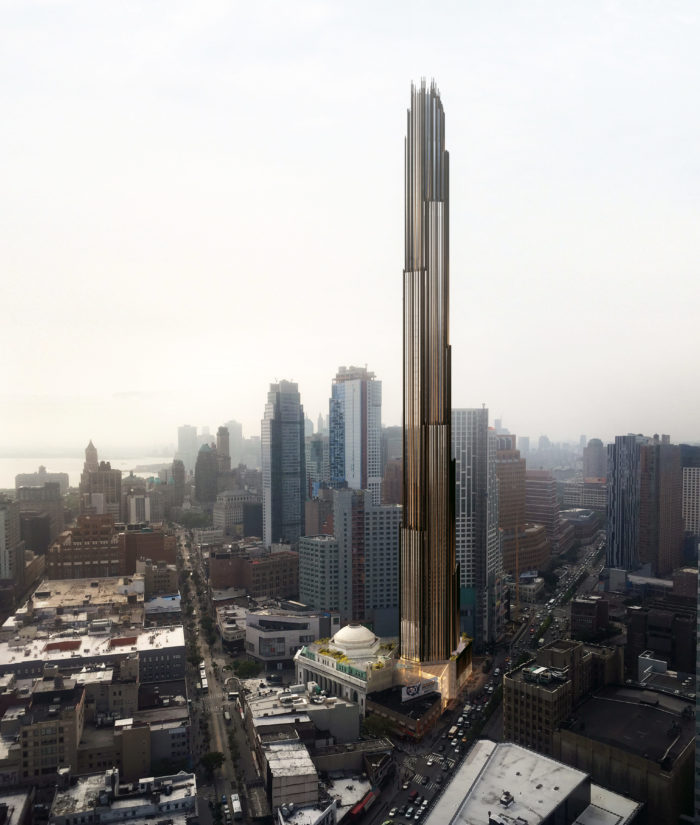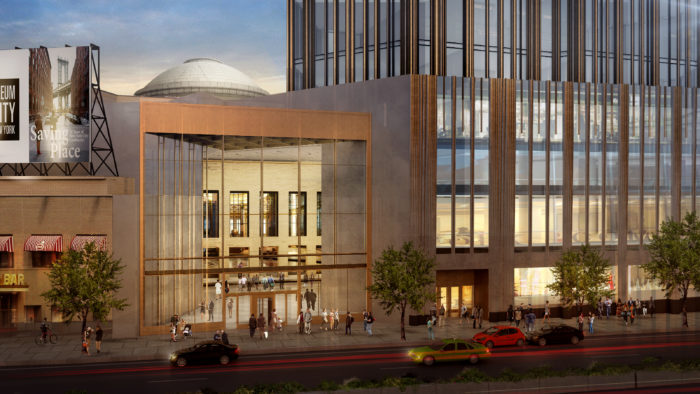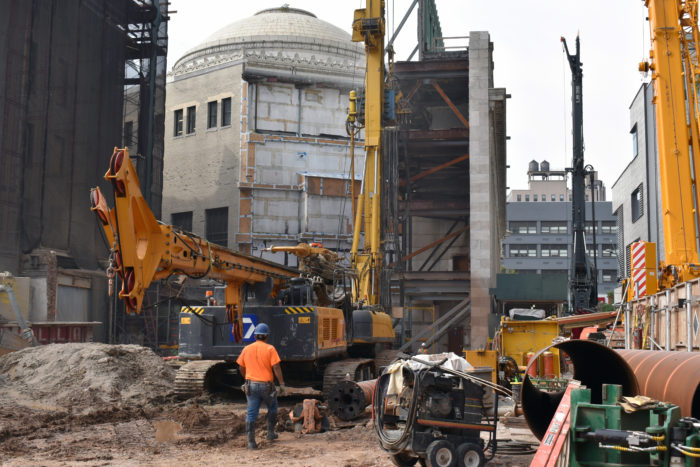When JDS Development Group began constructing one of Brooklyn’s highest-profile buildings earlier this summer, they announced it rather quietly, through Instagram. A video showed construction workers plunging caissons—massive, water-tight tubes—deep into a Downtown Brooklyn construction site at 9 DeKalb Ave.
Such foundational support is required when it comes to building a tower anticipated to reach 1,066 ft., which will make this by far the tallest structure to rise in the borough. 9 DeKalb, as the project is now known, might be an under-the-radar construction site now, but will soon be impossible to ignore. Years of planning have resulted in an architecturally complex, 73-story tower almost twice as high as anything surrounding it and the borough’s first supertall skyscraper, usually defined as 1,000 ft or more. It will easily dwarf the iconic 512-foot Williamsburgh Savings Bank Tower nearby, for decades the tallest in the borough.
9 Dekalb signals a number of transformations for Brooklyn: not just of the borough’s skyline, but of architectural quality and luxury real-estate offerings. So far, the tall, skinny towers designed by well-known New York architects, filled with condo apartments at record-setting prices, have been confined to Manhattan. This will be the first to debut in Brooklyn, something that’s not lost on the developer or architect.

The 1,066 ft. tower will become the dominant edifice on the Brooklyn skyline (Rendering courtesy of SHoP Architects)
“We see this as the crescendo of the skyline of Brooklyn,” said Gregg Pasquarelli, co-founder of SHoP Architects, the firm selected by JDS to create an iconic skyscraper design. “[JDS] believed that if we’re going to build the tallest building in the borough, it better be a serious piece of architecture with incredible quality,” he said. “Money is being spent in the facade, and the building, and the way it meets the street, because millions of people are going to see it every single day.” Michael Stern, founder of JDS, laid it out like this: “We believe in Brooklyn. It deserves a best-in-class skyline.”

Michael Stern, head of JDS Development Group (Photo courtesy of JDS)
SHoP took inspiration from the landmarked Dime Savings Bank, located at the site and to be integrated into the tower. The Greco-Roman masterpiece opened in 1908, when Brooklyn was going through an earlier architecture boom influenced by the Guided Age. JDS and its partner the Chetrit Group bought the former bank site in 2015, which was adjacent to a property they already owned. Stern was attracted to the site because of its central location off the Flatbush Avenue Extension as well as the existing landmark, and asked ShoP to consider both in their design.
The result is a facade of glass and bronze, with an interlocking hexagonal design and spiraling setbacks as the tower reaches its peak. “The hexagons came from the historic fabric of the bank, which used hexagons and six-pointed stars to deal with the triangular site,” Pasquarelli said.
The evolution of Downtown Brooklyn and its economy paved the way for the project. A 2004 residential up-zoning in the area permitted tower development, but for years the borough was seen as a budget alternative to Manhattan. In effect, new development brought plenty of generic apartment buildings and towers. All that, of course, is changing: “Brooklyn isn’t seen as a price alternative anymore, it’s a lifestyle choice,” as Pasquarelli put it.

Gregg Pasquarelli, principal at SHoP Architects (Photo courtesy of SHoP)
As the borough’s popularity became something of a global phenomenon, the architecture and development began to follow suit. The 9 DeKalb team isn’t shy about assigning global weight to the project. Marci Clark, the director of marketing and communications for JDS, called it a building with “global significance and global interest,” while Stern called the tower a “skyline icon” for an “authentic, globally recognized culture.”
Though Brooklyn is best known for its low-rise architecture—from bank buildings to churches to brownstones—JDS, based in Manhattan, doesn’t see itself as fostering the Manhattanization of Brooklyn. “Trying to strike that balance between old and new is very important to us,” said Clark. “From a design standpoint, it was never about bringing Manhattan to Brooklyn.” Pasquarelli said the Brooklyn tower doesn’t compare to another supertall the architecture firm is designing for JDS, 111 West 57th St. in Manhattan (a tower that is reportedly running over budget). “There’s a kind of genteel-ness there,” he said. “At 9 DeKalb, we were interested in it being a little more brute … a deeper, darker, slightly more badass aesthetic that’s appropriate for Brooklyn.”
Not everyone in Brownstone Brooklyn is delighted, however, with the prospect of a spiky new skyline looming overhead. In nearby Boerum Hill, a civic group is circulating a petition asking the city to require the downsizing of the proposed, 74-story tower at 80 Flatbush Ave. The Boerum Hill Association is concerned that the large, mixed-use complex being planned by Brooklyn’s Alloy Development “will not integrate or respect the scale and design of our adjacent brownstone neighborhood.” Some architecture critics, for their part, have complained that such buildings isolate their residents in gilded cocoons.

The facade of 9 DeKalb fronting on Flatbush Avenue (Rendering courtesy of SHoP Architects)
Tall buildings, however, can generally add to a city’s economic health and sustainability. “Density is a key factor in improving our impact on the environment. Both the Bloomberg and de Blasio administrations have fallen in line with this thinking and very tall buildings are a necessary part of the way forward,” David Erdman, chair of Graduate Architecture and Urban Design at Pratt Institute, told The Bridge. “A key issue is how to make that density habitable, desirable and tenable.”
About the complaint that new towers seem out of scale with their surroundings, Erdman noted, a new supertall building “will not fit into its ‘context.’ That is, if you consider context as something stable. Often, we are asked to design for a context that is not yet there. The knee-jerk, ‘make-it-look-like-its-surroundings’ approach does not really work in a rapidly growing, dense city that is looking to conserve resources.”
As for the specific aesthetic of 9 DeKalb, Erdman thinks the renderings suggest an appropriately bold direction. “If you are going to go tall, you might as well augment the slenderness and tallness of the building, which is adroitly executed in this design,” he said. “Making the verticality of the design a central concept and finding a way to detail it within that framework gives the building a slightly uncanny and sublime quality.” Other experts have concurred. At a Landmarks Preservation Commission meeting last April, in which the agency approved plans to alter the bank landmark to build the tower, commissioner Frederick Bland, an architect and Brooklynite, called the proposal an “exhilarating” example of “urbanism at its best.”

Construction underway early this week on the foundation of the future supertall skyscraper (Photo by Steve Koepp)
Still, it’s hard to deny the tower will bring a level of luxury to the borough more commonly on display in Manhattan. “From the very beginning, JDS told us not to think of this as a second-tier or second-city development,” Pasquarelli said. “It needed to be of the level and quality of a tower on Park Avenue or Fifth Avenue.” While interior renderings have yet to be released, Clark promised “finishes unlike anything the borough has seen.”
Construction is expected to last until 2020, according to Stern. When the tower opens, it will contain more than 500 rental apartments as well as retail stores within its base, which includes the restored bank. It’s too early to talk about prices, the developers say, but those are likely to break some records, too. For now, the tower is beginning its ascent to the top of the borough’s skyline, and the team suspects 9 DeKalb will change the game once it peaks.
“The most idiotic thing to do would be to stack conceptual brownstones on top of each other here,” Pasquarelli said. “This is a completely different typology of building for Brooklyn. But it will be the peak of that skyline that you see in the distance from sitting in your Brooklyn backyard.”